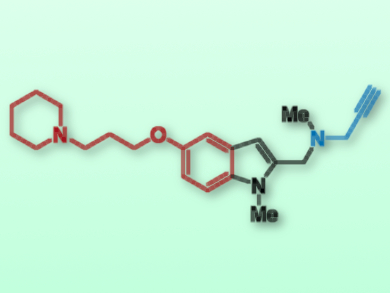Common neurodegenerative diseases such as Alzheimer’s or Parkinson’s disease have no cure, although numerous biochemical targets offer options for drug therapy. Multitarget-directed drugs could be used to fight the complex mechanisms that underlie such diseases.
Javier Egea, Hospital Universitario de la Princesa, Madrid, Spain, José Marco‐Contelles, Laboratorio de Química Médica, Madrid, Spain, Holger Stark, Heinrich-Heine-Universität, Düsseldorf, Germany, and colleagues have synthesized indole derivatives that simultaneously target different enzymes involved in neurotransmitter breakdown and signaling (namely, acetyl/butyrylcholinesterases and monoamine oxidases A/B as well as the histamine H3 receptor H3R).
The team combined various structural motifs to produce antioxidative/neuroprotective drugs that are capable of penetrating the blood–brain barrier. The most promising in vivo candidate, contilisant (pictured), is a potent inhibitor of monoamine oxidases with irreversible binding properties and was able to improve cognitive deficiencies in mice at 1 mg kg–1. This study suggests that the treatment of neurodegenerative diseases could benefit from a multitarget drug-design approach that addresses several elements of a complex disease mechanism simultaneously.
- Multitarget-Directed Ligands Combining Cholinesterase and Monoamine Oxidase Inhibition with Histamine H3R Antagonism for Neurodegenerative Diseases,
Óscar M. Bautista-Aguilera, Stefanie Hagenow, Alejandra Palomino-Antolin, Víctor Farré-Alins, Lhassane Ismaili, Pierre-Louis Joffrin, María L. Jimeno, Ondřej Soukup, Jana Janočková, Lena Kalinowsky, Ewgenij Proschak, Isabel Iriepa, Ignacio Moraleda, Johannes S. Schwed, Alejandro Romero Martínez, Francisco López-Muñoz, Mourad Chioua, Javier Egea, Rona R. Ramsay, José Marco-Contelles, Holger Stark,
Angew. Chem. Int. Ed. 2017.
DOI: 10.1002/anie.201706072




